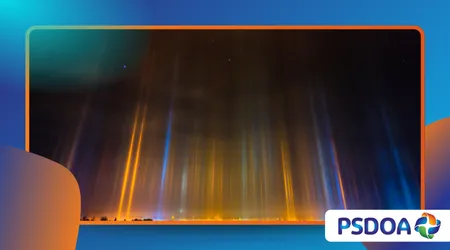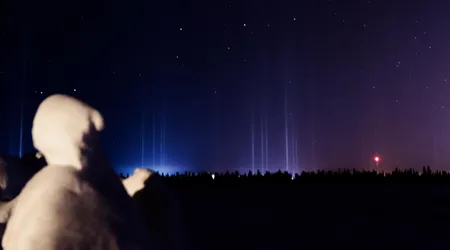Light Pillars: Vertical Beams of Ice and Light in Winter Skies

The captivating spectacle of light pillars is a rare atmospheric phenomenon. These stunning vertical beams of light stretch high into the winter sky.
Anúncios
They often appear to originate from a light source on the ground or from the Moon. These pillars are a mesmerizing display of nature’s artistry.
Contrary to what some might think, they are not an alien signal. Instead, a light pillars is an optical illusion. It is created by the interaction of light and tiny ice crystals. The physics behind this phenomenon is fascinating and complex.
The phenomenon occurs most often during extremely cold weather. The air must be calm, without wind. This allows the ice crystals to remain perfectly horizontal. Without these flat, hexagonal crystals, the pillars cannot form.
The crystals act like millions of tiny mirrors. They reflect the light from below. As the light hits the flat surfaces of the ice crystals, it is bent downwards towards the observer. This creates the illusion of a solid column of light.
Anúncios
They can appear in a wide variety of colors. The color depends on the light source. Streetlights often produce yellow, white, or orange pillars. Moonlight creates a soft, ethereal, and ghostly white light pillars.
This stunning visual is a reminder of the hidden beauty in nature. It is a spectacle that requires very specific conditions. That’s what makes a light pillars so special and fleeting.
The Science Behind the Spectacle
To truly appreciate a light pillars, one must understand its scientific basis. The ice crystals responsible are called hexagonal plate crystals. These crystals are shaped like tiny, six-sided plates.
They are formed when water vapor freezes in the upper atmosphere. The air must be still for them to align correctly. Even a small gust of wind can disrupt their formation. This is why the phenomenon is so rare.
The crystals fall slowly through the air. As they descend, their flat, horizontal surfaces are held in place by air resistance. This perfect alignment is the key.
The light source, whether a city or the Moon, sends out light rays. These rays travel upwards into the atmosphere. They then hit the perfectly flat surface of the ice crystals.
++ Moonbows: Rainbows That Only Appear at Night
The light reflects off the bottom of the crystals. It is a simple principle of reflection. The light bounces back downwards. The millions of reflections create the continuous beam of light.
An example of this is seen in urban areas. Streetlights or stadium lights produce a stunning display. The light rays travel upward, are reflected by the crystals, and produce a powerful light pillars.
Another example is seen in rural areas. The full Moon can produce a beautiful, shimmering pillar. It is often a more subtle and ghostly light pillars than its urban counterpart.

The Conditions for a Perfect Viewing
To witness a light pillars, one needs a unique combination of factors. The air must be extremely cold. The temperature should be around -10°C or colder. This ensures the formation of ice crystals.
The air must be calm and still. There should be very little or no wind. Wind would cause the crystals to tilt. This would break the vertical illusion.
The sky must be clear, or have very high, thin clouds. Low or thick clouds would block the light source. You wouldn’t be able to see the pillars.
The light source must be strong and well-defined. Bright streetlights, car headlights, or the Moon work best. The stronger the source, the more dramatic the pillar.
The viewing location matters as well. You need to be far away from the light source. This allows the pillar to fully form and be visible.
Also read: Blood Falls in Antarctica: Iron-Rich Water That Bleeds From Ice
A great opportunity for seeing light pillars is in the northern hemisphere. Places like Canada, Russia, and Scandinavia are known for them. The cold winter nights are ideal.
What makes them so appealing? Is it their fleeting nature? Or is it the magic of seeing something so rare and beautiful? This is a question to ponder.
A Common Misconception
It is a common misconception that a light pillars is related to the Aurora Borealis. While both are light-based phenomena, they are completely different. The Northern Lights are caused by charged particles from the sun hitting Earth’s magnetic field.
Light pillars, on the other hand, are a meteorological event. They are created by local atmospheric conditions. They don’t require any solar activity.
The two phenomena can sometimes appear at the same time. This is because both require very cold temperatures. But they are not causally linked.
Read more: Fire Whirls: Tornadoes Made of Flame
An analogy is seeing a rainbow and a solar eclipse. Both are optical events. They can sometimes happen on the same day. But they are caused by completely different things.
This distinction is important. It helps us understand the true nature of each event. It also helps us search for them in the right way.
According to a 2024 meteorological study published in the Journal of Atmospheric Optics, sightings of light pillars have been tracked globally.
The study found that urban light sources are now the most common cause of these phenomena. This is due to increased light pollution in major cities.
| Light Source | Typical Appearance | Common Location |
| Streetlights | Bright, colorful beams | Urban and suburban areas |
| Car Headlights | Thin, vertical beams | On roads and highways |
| Moonlight | Faint, white columns | Rural areas, away from city lights |
| Sunlight | Can form sun pillars at sunrise/sunset | Anywhere with clear skies and low sun |
This table shows how the source of light changes the appearance.
Historical Context and Modern Sightings
Throughout history, people have viewed light pillars with awe. They were often mistaken for supernatural events or signs from the gods. They inspired myths and legends.
Today, with modern science, we understand their origin. But the magic of seeing them has not faded. They still inspire wonder.
The widespread availability of smartphone cameras has increased sightings. People can now easily capture and share these moments. This has made the phenomenon more well-known.
Social media is full of pictures of light pillars. People share their discoveries with others. This has turned a rare event into a shared global experience.
It’s a beautiful example of how nature and human technology can intersect. Our lights create a canvas. Nature’s ice crystals paint a masterpiece.
Frequently Asked Questions
1. Are light pillars dangerous? No, light pillars are completely harmless. They are a natural optical phenomenon and pose no threat.
2. Can light pillars happen in the summer? No, light pillars require ice crystals to form. They only occur in extremely cold temperatures, making them a winter-specific phenomenon.
3. What’s the best time to see a light pillar? The best time is on a cold, calm, and clear winter night. Look for them in areas with strong light sources, such as cities or stadiums.
4. Why are they so rare? They require a very specific combination of conditions: extremely cold weather, no wind, and flat, hexagonal ice crystals perfectly aligned in the atmosphere.
5. Do I need special equipment to see them? No, you don’t need any special equipment. Light pillars are visible to the naked eye. However, a camera can help you capture their beauty.
